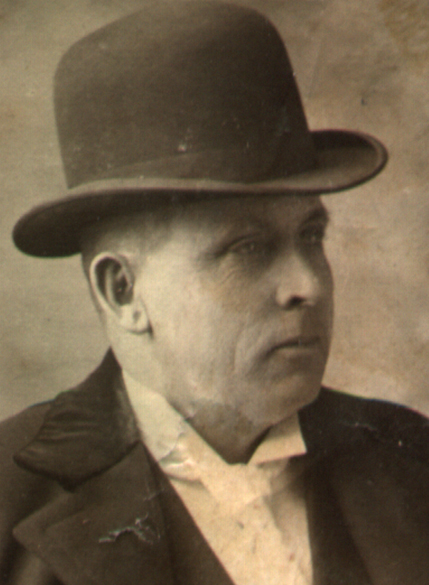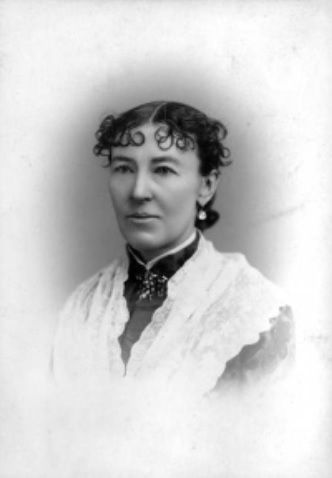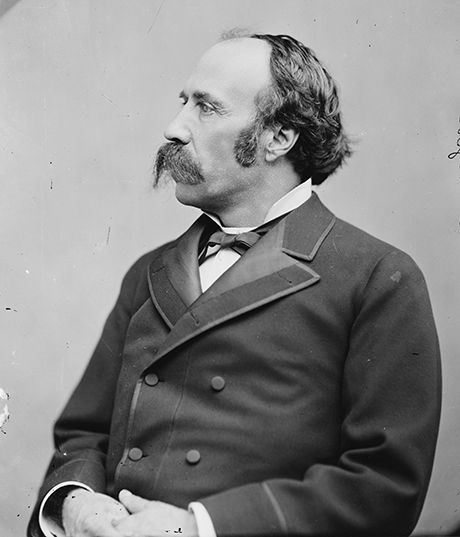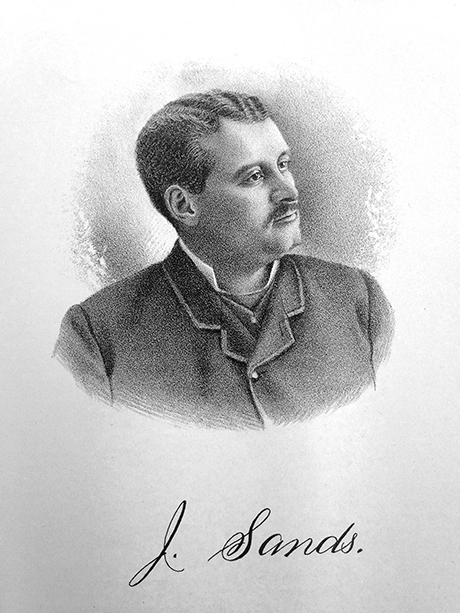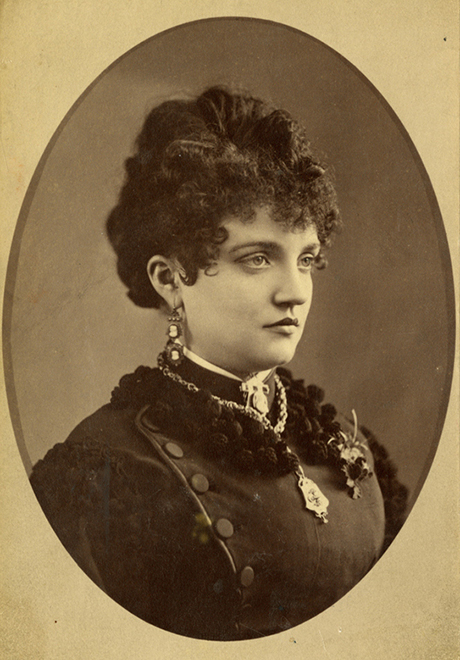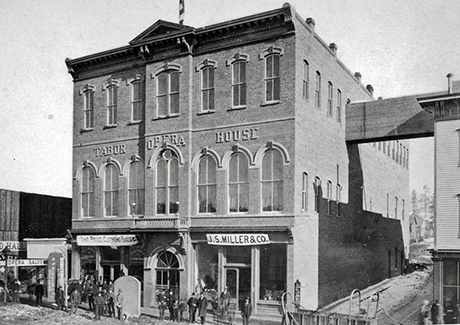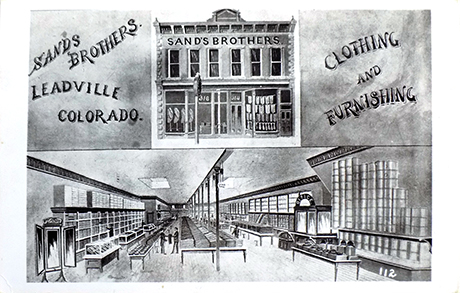Introduction
Jacob Sands, then operating under his given name, Jacob Sandelowsky, met Harvey and Elizabeth “Baby”[1] McCourt Doe during 1878 after the couple had moved to Black Hawk, Colorado, from Oshkosh, Wisconsin, in pursuit of their gold mining dreams. There Jake operated the first of his many clothing stores in the western United States under the name of Sandelowsky, Pelton & Co. Jake met the Does through normal business activity in his store. The young, attractive “Baby Doe”, a nickname that developed during her time in the mining community, lived where women were scarce and standout beauties like Mrs. Doe were far more of a rarity. Not uncommon in mining communities, Harvey was often busy in distant mining camps seeking his fortune and soon Harvey’s absence led to rumors of a romantic relationship between Jake Sands and Elizabeth Doe. This resulted in a pregnancy and subsequent birth of a stillborn boy in 1879. The episode would shortly contribute to the end of the Doe marriage and ultimately facilitate Elizabeth meeting Horace Tabor whom she would marry in 1882.
Analysis Of Resources
Although the relationship between Jacob and Elizabeth has not escaped historical inquiry, the details have been cloudy at best. Many historians have discussed the relationship, at least in brief, for nearly a century. What becomes problematic is the integrity of the secondary resources which were published between 1932 and 1955 and are most cited, even by contemporary historians. The bulk of the issues stem from irregularities found in the work of the most frequently cited historian and self-proclaimed Tabor expert: Caroline Bancroft.
Bancroft researched the Tabor story extensively throughout her career as an author of Colorado history and travel books and through some nefarious activities did indeed accomplish her goal of establishing herself as the authority on the Tabor story. However, she did this through highly questionable means which included the pilfering and hoarding of primary documents such as letters, photographs, and newspaper articles from Leadville institutions. Some of this activity left enduring scars. According to Leadville historian Janice Fox, who oversees the Colorado Mountain History Collection at the Lake County (Colorado) Public Library, Bancroft clipped articles from the archives of Leadville newspapers prior to the initiation of any microfiche programs and some have never been recovered. [2] In addition, Bancroft raided the Baby Doe Tabor cabin at the Matchless Mine in Leadville and absconded with photographs and documents. [3] This ultimately rendered Bancroft’s historical representations of the Tabors as irrefutable simply because no information could be found to argue against Bancroft’s claims.
An example of Bancroft’s misappropriation of resources is reasonably documented and appears in Marylin Griggs Riley’s book, High Altitude Attitudes: Six Savvy Colorado Women, in which Riley reprinted a 1955 letter from photographer Fred Mazulla, a victim of Bancroft’s misappropriations:
Dear Miss Bancroft,
Would you be so kind as to mail to my office my 8 X 10 photographs of the interior of the Baby Doe (Elizabeth Tabor) cabin. I would also appreciate the return of the pictures you took from this cabin some time ago.
In the future please do not use my name or any of my pictures in your publications, unless you obtain my permission in writing beforehand.
Very Truly Yours,
Fred M. Mazzulla[4]
Also problematic is that in Bancroft’s 1955 book, Silver Queen: The Fabulous Story Of Baby Doe Tabor, [5] she assumes the character of Elizabeth Tabor in the telling of her autobiographical life story. This in itself is detrimental to scholarly integrity; speaking in Elizabeth Tabor’s voice calls for an operation of Elizabeth Tabor’s mind, which can never be substantiated. Bancroft would later weakly defend the dialog she created for Elizabeth Tabor: “I don’t know that that person said that thing at that moment. But they jolly well better had because I had done so much research that I knew it was the kind of thing they would have said.” [6]
Furthermore, in 1974 Bancroft fully admitted to “fictionalizing” her historical accounts to make her work more interesting to a generalized audience. “I improve history when it seems logical, my characters talk, dress up and get involved in things because history has to have popular appeal.” This was oddly defended by Colorado State University American history professor Liston E. Leyendecker who explained that Bancroft’s actions were excusable because if she could get a casual reader more interested in history, they could then attend a university where they could be educated appropriately. [7]
The discussion on Bancroft leads us to what other historians have written about the Sands-Tabor affair. Many of these accounts stem from a solitary resource and that is Caroline Bancroft. Some historians have supplemented their citations of Bancroft with minor explorations of primary resources to help to bolster their arguments and likely the most in-depth approach to date is the effort by Judy Nolte Temple in her 2007 book Baby Doe Tabor: The Madwoman in the Cabin. [8] Temple does note Bancroft’s research and its issues, but substantiates her findings with primary resources that give a far more scholarly accounting of the relationship between Jake and Elizabeth along with a discussion of how Temple arrived at her own conclusions. For all of Bancroft’s integral imperfections, there are elements of her story that can still be substantiated through careful study of primary resources. For that reason, Bancroft’s work provides at least a limited value to research even if only to provide a guideline for the exploration of more scholarly materials.
Through use of scholarly secondary resources, along with a wealth of surviving primary documents found at the Hart Research Library, The Colorado Historic Newspaper Collection, and the Lake County Public Library, the facts surrounding the relationship between Elizabeth Tabor and Jake Sands can be better substantiated. A reasonable timeline can now we constructed for the Sands-Tabor relationship and a better understanding of the major events that resulted can be established.
The second most cited resource on the Tabors has issues that are more easily explained and this is David Karsner’s 1932 effort, Silver Dollar: The Story of the Tabors, [9] and subsequent Warner Brothers motion picture Silver Dollar starring Edward G. Robinson of the same year. [10] Karsner wrote his biography while Elizabeth Tabor was still very much alive, and the Warners were so concerned with possible litigation that pseudonyms were used in the movie adaptation. In fact, the relationship between Elizabeth and Jake is simply not mentioned in either presentation, very likely for this reason. Although the Warners claimed to have invited Elizabeth to the premier in Denver, she did not attend or read the book and thus she never contested the authenticity of their contents. [11] Karsner clearly wrote the book as a novel and it is simply not a scholarly resource.
Black Hawk & Central City, Colorado, 1877-1879
When the newlyweds Harvey and Elizabeth Doe arrived in the mining boomtown of Black Hawk, Colorado in 1878, Jacob Sands (Sandelowsky) had already established himself within the community. Jake was partnered with Sam Pelton in Sandelowsky, Pelton & Co, [12] a popular clothing store in Black Hawk, Colorado. Elizabeth would frequent the establishment, window shopping and daydreaming about the fine items among the store’s inventory that she had hoped Harvey’s mining endeavors would afford her. Soon Jake established a friendship with both of the Does, however he appears to have become more familiar with Elizabeth as Harvey spent most of his time in the fields pursuing of his fortune. [13]
Jake’s relationship with the Does took an interesting twist in late September of 1878. Rumors of an inappropriate relationship between Jake and Elizabeth had been circulating about town and become further substantiated through one of Elizabeth’s many scrapbooks. One page, dedicated to Jake, notes that Jake kissed Elizabeth three times on the schoolhouse steps and professed his love to her on September 25, 1878. [14] Be it through innuendo, Elizabeth’s confession, or Harvey locating the scrapbook entry is not clear, but the damage to the Doe marriage appears to have been fatal and a cleft developed between Harvey and Elizabeth shortly thereafter. This resulted in the first of Harvey’s multiple departures from the couple’s home. He returned briefly in late November of 1878, and then, at the urging of his mother, Harvey left for Oshkosh, Wisconsin, before Christmas of that year. Harvey returned to Colorado in late 1879 after his father brokered a deal with Elizabeth for the couple’s reconciliation. At the same time the elder Does moved to Colorado to keep a watchful eye on the young couple. [15]
Harvey did return to Colorado periodically over the months to follow, but two of the events that Caroline Bancroft claimed to have occurred, simply did not: Harvey was not present in Black Hawk at the time Elizabeth’s stillborn baby would have been conceived in mid-October of 1878, nor was he present with Jake and Elizabeth during the arrival of the stillborn baby on July 13, 1879. [16] Although there is a remote possibility that someone other than Jake could have been the father of this baby, the likelihood is slim; no suspicion of another suitor has been uncovered through rumor, evidence, or innuendo.
It is more than likely that the somewhat public relationship between Jake and Elizabeth was far too much for Harvey to overcome. There were documented attempts to reconcile the Doe marriage, but these ultimately failed. The Does moved to Idaho Springs, where Jake coincidently opened a new branch of his store. Elizabeth filed for divorce on March 1, 1880, alleging adultery after witnessing Harvey entering a brothel. The complaint was later amended to “abandonment” and “failure to support”, [17] far more frequent causes for divorce in mining communities at the time.
Leadville, Colorado And Horace Tabor 1880-1914
After the divorce things become a bit less clear, but the romantic relationship between Jake and Elizabeth continued, albeit rather briefly. In need of support, Elizabeth followed Jake to Leadville where she worked in the new store owned by her paramour and Sam Pelton located on the ground floor of the Tabor Opera House. It is evident that Jake was intent on marriage, but shortly after her arrival Elizabeth set her sights on Horace, Jake’s current landlord and business partner in two mines. It was not long before Elizabeth turned a cold shoulder towards Jake and a gleaming eye in Horace’s direction.
Moving forward from 1880 largely revolves around the more tantalizing story of the Tabors’ romance and whatever ill-feelings that may have developed between Horace and Jake quickly subsided. There is no evidence to support Caroline Bancroft’s claim that Horace and Elizabeth met at the Saddle Rock Café (apparently not in business until 1881) and fell instantly in love. [18] In fact, it is far more likely that Horace, whose Leadville residence was in the Tabor Opera House above Jake’s store, inevitably met Elizabeth in the company of Jake Sands while she was working at Sands & Pelton’s One Price Clothing Store. There are also unsubstantiated rumors that Elizabeth, by way of Horace, paid Jake $1,200 in compensation for generosities, principally a diamond ring, Jake had bestowed upon her [20] during her brief stint as a divorcee. However, it seems more than likely Jake simply gave up on his vexatious pursuit of Elizabeth and placed a greater value on his business relationship with Horace.
The evidence of a rift and/or separation developing between Jake and Elizabeth in 1880 is substantial and coincides with her meeting with Horace. It surfaces in Jake’s letters during this period:
“I was very sad thinking you would not open your door for the man who loves and worships you. I was upset to learn that yesterday and thinking of the past made me very very sad, looking at the old windows from which I received once many smiles and to day you would not look at me coming at your door. Babe I know you are awfull proud, butt remember you must not throw such a dreadful blow upon me at once. The man could once, and I believe with all your heart, if you only my broken heart. I know you would talk a few kind words to me, or is this my fault. I know you (distorted: likely “loved”) me once, truly and faithfull all a woman can (damaged and distorted) and I know I was not deceived in your (distorted: likely “love”, and an undetermined conjunction) dear to you. I am living for you and you only. It is no matter howe you hate me, butt I shall always love you, it is not a hour in the day butt I think of thee and your sweet face stands before me, before living central (first portion of this line is torn and missing) so dear to you and to me, and I thought it is it possible that you have learned to hate me? I can not for one moment believe it. “ [21]
There is no correspondence which exists between Elizabeth and Jake from the time she married Horace in 1882 until Horace’s death in 1899. Jake eventually married Leah Huffman in 1892. There are letters that reveal a continuing relationship between Jake and Horace that remained intact until Tabor’s death from peritonitis in 1899. [22]
In Gordon Langley Hall’s 1962 book, The Two Lives of Baby Doe, Langley notes that Elizabeth and her daughter, Silver Dollar Tabor, moved into Jake Sands’ former home at 303 Harrison Avenue in 1901, [23] however this claim is not referenced. The Leadville City Directory does show an E.M. Tabor (This is how Elizabeth would have likely identified herself, “Baby” was an unladylike nickname she acquired in Black Hawk and “Doe” a reference to her failed marriage; E.M. would likely be the initials for Elizabeth McCourt Tabor) living at 420 East 6th Street in 1901, with a listed occupation as “Diamond Drillman”, but nothing that points to 303 Harrison Avenue which in 1880 were the offices of Dr. G.H. Moulton. [24] In 1880, Sands resided at his store in the Tabor Opera House and he continued to do so until moving to Aspen where he remained from 1890-94. [25]
As time passed, correspondence between Elizabeth and Jake escalated around the turn of the century, but here is nothing that can be substantiated about a continued romantic connection between the two, however the tone of Jake’s letters is something far more than cordial in demeanor. There is also an autobiographical manuscript, written shortly before Horace’s death, that paints a less than flattering opinion of first wife Augusta Tabor, their son, Maxey Tabor, and Elizabeth:
“In regard to my matrimonial life; It has been unsatisfactory and I wish that you would omit that entirely. I think it would be better. As to my son; he is no son of mine, and I would wish you would omit this, but I suppose you are compelled to report it.” [26]
Letters also reveal that Jake not only remained close to Elizabeth but also to her daughter, Silver Dollar Tabor, as well. [27] Jake followed the mining booms around the Southwest after leaving Leadville in 1906 and made sure to notify Elizabeth and Silver of his whereabouts every time he changed locations. All of the missives take a very affectionate tone and sometimes note money loaned to, or borrowed from, the Tabors. These letters mark the continuation of a relationship between Elizabeth and Jake that establish a chain of correspondence that lasted over five decades, can be fully substantiated into 1914, [28] and likely continued until Sands’ death in Bisbee, Arizona on March 29, 1917. [29]
Although correspondence between the two cannot be found after 1914, Elizabeth still thought of Jake uxoriously after his death in 1917 as evidenced by her scrapbook entry a year later:
“I fell asleep again & dreamed of lying in bed & looking through the door in another room & seeing my dear sister Tilly lying in a bed & Jake Sands came to her & stood by her bed & talked to her happily he looked fat & fine dressed fine light straw hat on & long gold & pearl earrings hanging in his ears he did not notice me until I called him & he came and sat on my bed I said O my what earrings you have & he laughed and said see they were horrid cheap brass worst kind 5c earrings to make him feel bad I said I am going to a convent he said O no they should help you with your work. I said I have fixed all fine & taken care of all of them & you. March 27, 1918.” [30]
Conclusion
Through the exploration of primary resources and previous research regarding the Sands-Tabor affair reveals that Jake and Elizabeth’s relationship was far more than a trifling dalliance, but a lifelong friendship that endured its share of peaks and valleys. Proving the depths of this relationship to courtroom standards a century after the last event is next to impossible, but careful study of resources has uncovered greater detail and a reasonable substantiation of events that occurred over the course of the Sands-Tabor relationship. It is highly evident that Sands was the father of Elizabeth’s stillborn in 1879, that Sands was the catalyst for the demise of the Doe marriage, and that he was the unintended conduit for the meeting between Elizabeth “Baby” Doe and Horace Tabor.
1 The name “Baby Doe” in reference to Elizabeth Bonduel McCourt Tabor is the stuff of popular legend, and has become the signature, and unfortunately, historical name for Elizabeth. “Baby” was a nickname endowed on Mrs. Tabor during her time in Black Hawk and Central City, Colorado, sometime in 1878 and “Doe” is in reference to her first husband whom she divorced in 1880. This has become the trademark moniker for Elizabeth Tabor, however, it is highly unflattering, borne from the catcalls of titillated, lonely miners, and not a name she was known to have ever used in addressing herself. For these reasons, and as a matter of respect, the use of the name “Baby Doe” has been intentionally avoided in this article.
2 Jeffrey Grant. “Interview With Janice Fox”. Temple Israel Foundation. Leadville, CO, USA. August 3, 2018.
3 Marilyn Griggs Riley. High Altitude Attitudes: Six Savvy Colorado Women. Boulder, CO, USA: Johnson Books, 2006. P117.
4 Marilynn Griggs Riley. High Altitude Attitudes: Six Savvy Colorado Women. 2006. P118.
5 Caroline Bancroft. Silver Queen: The Fabulous Story of Baby Doe Tabor. Boulder, CO: Caroline Bancroft, 1955.
6 Marilynn Griggs Riley. High Altitude Attitudes: Six Savvy Colorado Women. 2006. P118.
7 Marilynn Griggs Riley. High Altitude Attitudes: Six Savvy Colorado Women. 2006. P120.
8 Judy Nolte Temple. Baby Doe Tabor: The Madwoman in the Cabin. Norman, OK, USA: University of Oklahoma, 2007. P81.
9 David Karsner, Silver Dollar: The Story of the Tabors. New York, N.Y; USA: Covici-Friede, 1932.
10 Silver Dollar. Directed by Alfred E. Green. United States: Warner Bros., 1932. Film.
11 John Burke. The Legend of Baby Doe: The Life and Times of The Silver Queen of The West. Lincoln, NE, USA: University of Nebraska Press, 1989. P33.
12 “Landelouski, Pelton & Co.”. Georgetown, CO; USA. Colorado Miner. January 10, 1880. P1.
13 John Burke. University of Nebraska Press. Lincoln, NE; USA. 1989. Pp. 29-31.
14 John Burke. University of Nebraska Press. Lincoln, NE; USA. 1989. P. 27.
15 Judy Nolte Temple. Baby Doe Tabor: The Madwoman in the Cabin. Norman, OK, USA: University of Oklahoma, 2007. P 9-11.
16 Tabor Scrapbook III. History Colorado-Hart Research Library. Denver, CO, USA. MSS-614. FF-1438.
17 Elizabeth B. Doe V. William H. Doe. History Colorado-Hart Research Library. [Legal Document]. (1880). Denver, CO; USA. MSS-614. FF-1314.
18 Caroline Bancroft. Silver Queen: The Fabulous Story of Baby Doe Tabor. Boulder, CO, Caroline Bancroft, 1955. Pp. 37-38.
19 TB Corbett, WC Hoye and JH Ballenger. “Corbet, Hoye and Co’s First Annual City Directory: Containing a Complete List of the Inhabitants, Institutions, Incorporated Companies, Manufacturing Establishments, Business, Business Firms etc. in The City Of Leadville for 1880”. Democrat Printing Company; Leadville, CO, USA. 1880. P349.
20 John Burke. The Legend of Baby Doe: The Life and Times of The Silver Queen of The West. Lincoln: University of Nebraska Press, 1989. Pp. 33-35.
21 “Jake Sands to Elizabeth Doe”. (Letter). History Colorado-Hart Research Library. Denver, CO; USA. MSS614: B1, FF2, Item 1. 1880.
22 Jake Sands. “Jake Sands to H.A.W. Tabor”. (Letter). Denver, CO; USA. History Colorado-Hart Research Library. MSS614. B4. FF117. I2. September 20, 1894.
23 Gordon Langley Hall. The Two Lives of Baby Doe. Philadelphia, PA, USA. Marcie Smith. 1962. P45.
24 TB Corbett, WC Hoye and JH Ballenger. “Corbet, Hoye and Co’s First Annual City Directory: Containing a Complete List of the Inhabitants, Institutions, Incorporated Companies, Manufacturing Establishments, Business, Business Firms etc. in The City Of Leadville for 1880”. Democrat Printing Company; Leadville, CO, USA. 1880. P425.
25 Matt Hulstine. “Sands/Sandelowsky”. Leadville, CO, USA. Temple Israel Foundation. 2017. http://www.jewishleadville.org/sands-sandelowsky.html
26 Horace A. W. Tabor. “H.A.W. Tabor”. (Manuscript. ND). Leadville, CO, USA. Lake County Public Library-Colorado Mountain History Collection. 2018. Pp. 21-22.
27 Jacob Sands."Jacob Sands to Silver Dollar Tabor”. February 4, 1912. Bisbee, AZ, USA. History Colorado: Hart Research Library. B25. FF667. IN3.
28 Jacob Sands."Jacob Sands to Silver Dollar and ElizabethTabor”. July 30, 1914. Denver, CO, USA. History Colorado: Hart Research Library. B26. FF694. IN5.
29 “Death of Jake Sands”. Leadville, CO; USA. Herald Democrat. March 29, 1917. P5.
30 Judy Temple. “Baby Doe Tabor: The Madwoman in the Cabin”. 2007. P81.
Bibliography
“Baby Doe Tabor circa 1880-1885”. [Image]. Colorado Mountain History Collection. (2016). Leadville, CO, USA.
Bancroft, Caroline. Silver Queen: The Fabulous Story of Baby Doe Tabor. Boulder, CO: Caroline Bancroft, 1955.
Burke, John. The Legend of Baby Doe: The Life and Times of The Silver Queen of The West. Lincoln, NE, USA: University of Nebraska Press, 1989.
Corbett, TB, Hoye, WC and Ballanger, JH. “Corbet, Hoye and Co’s First Annual City Directory: Containing a Complete List of the Inhabitants, Institutions, Incorporated Companies, Manufacturing Establishments, Business, Business Firms etc. in The City Of Leadville for 1880”. Democrat Printing Company; Leadville, CO, USA. 1880.
“Death of Jake Sands”. Leadville, CO; USA. Herald Democrat. March 29, 1917.
Elizabeth B. Doe V. William H. Doe. History Colorado-Hart Research Library. [Legal Document]. (1880). Denver, CO, USA. MSS-614. FF-1314.
Grant, Jeffrey. “Interview With Janice Fox”. Temple Israel Foundation. Leadville, CO, USA. August 3, 2018.
Hall, Gordon Langley. The Two Lives of Baby Doe. Philadelphia, PA, USA. Marcie Smith. 1962.
Hulstine, Matt. “Sands/Sandelowsky”. Leadville, CO; USA. Temple Israel Foundation. 2017. http://www.jewishleadville.org/sands-sandelowsky.html
“Jacob Sands-Union Army”. [Image]. Temple Israel Foundation. (2018). Leadville, CO; USA.
Sands, Jake. “Jake Sands to Elizabeth Doe”. (Letter). History Colorado-Hart Research Library. Denver, CO, USA. MSS614: B1, FF2, IN1. 1880.
Sands, Jacob "Jacob Sands to Silver Dollar Tabor”. February 4, 1912. Bisbee, AZ, USA. History Colorado: Hart Research Library. B25. FF667. IN3.
Sands, Jacob "Jacob Sands to Silver Dollar and Elizabeth Tabor”. July 30, 1914. Denver, CO, USA. History Colorado: Hart Research Library. B26. FF694. IN5.
Sands, Jake. “Jake Sands to H.A.W. Tabor”. (Letter). Denver, CO, USA. History Colorado-Hart Research Library. MSS614. B4. FF117. I2. September 20, 1894.
Karsner, David. Silver Dollar: The Story of the Tabors. New York, N.Y; USA: Covici-Friede, 1932.
“Landelouski, Pelton & Co.”. Georgetown, CO; USA. Colorado Miner. January 10, 1880.
Riley, Marilyn Griggs. High Altitude Attitudes: Six Savvy Colorado Women. Boulder, CO;, USA: Johnson Books, 2006.
Silver Dollar. Directed by Alfred E. Green. United States: Warner Bros., 1932. Film.
Tabor, Horace A. W. “H.A.W. Tabor”. (Manuscript. ND). Leadville, CO; USA. Lake County Public Library-Colorado Mountain History Collection. 2018.
Tabor Opera House. [image]. History Colorado: Hart Research Library,. Denver, CO; USA. 2018. DOI: 89.451.5894
Tabor Scrapbook III. History Colorado-Hart Research Library. Denver, CO; USA. MSS-614. FF-1438.
Temple, Judy Nolte. Baby Doe Tabor: The Madwoman in the Cabin. Norman, OK;, USA: University of Oklahoma, 2007.
To cite any of the information in this biography, please use the following reference.
AUTHOR: Jeffrey P. Grant
EDITOR: William Korn
SOURCE: Life in Leadville/Colorful Conflicts/Sands-Tabor Affair
PUBLISHED BY: Temple Israel Foundation. Leadville, CO; USA. 2018
STABLE URL: http://www.jewishledville.org/sandstaboraffair.html

